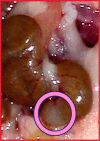The murine appendiceal microbiome is altered in spontaneous colitis and its pathological progression
- PMID: 25002910
- PMCID: PMC4085080
- DOI: 10.1186/1757-4749-6-25
The murine appendiceal microbiome is altered in spontaneous colitis and its pathological progression
Abstract
Background: Inflammatory bowel disease (comprising ulcerative colitis and Crohn's disease) is a multifactorial disease that is extensively associated with stool microbiome changes (dysbiosis). Appendicitis and appendectomy limits subsequent colitis, clinically, and in animal models. We wanted to examine how the appendiceal and stool microbiome fared in our spontaneous colitic Winnie (Muc2(-/-)) mice model.
Methods: Two C57BL/6 and 10 Winnie mice at ages 12 and 15 weeks were euthanized for stool and caecal patch samples. DNA was extracted using the QIAamp DNA Stool Mini Kit then the V1-V3 hypervariable region of the 16S rRNA gene was sequenced using the Roche/454 GS FLX + pyrosequencing instrument. A Galaxy metagenomic pipeline was used to define phyla and families at sequence similarity threshold of ≥ 80%.
Results: Bacteriodetes was decreased in 15-week Winnie mice appendices compared to corresponding stool samples (P < 0.01). Proteobacteria was increased in appendices of Winnie mice compared to corresponding stool samples (P < 0.05). The Bacteroidetes family Rikenellaceae could be identified only in 15-week-old Winnie mice appendices. A higher quantity of Acetobacteraceae (Proteobacteria phylum) was present in 15-week Winnie mice when compared to 12-week Winnie mice (P < 0.01). Helicobacteraceae (Proteobacteria phylum), which is prominent in all Winnie mice, is absent in control mice.
Conclusions: The appendiceal dysbiosis observed in our Winnie mice is commensurate with, and adds to extant literature data. The presence of Helicobacteraceae (Proteobacteria) only in colitic Winnie mice (but not control mice) is consistent with reports of increased Helicobacter in IBD patients. Bacteroides (Bacteroidetes) decreases may be a reflection of reduced anti-inflammatory commensal species such as B. fragilis. Further research is warranted to expand and delineate the relationship between IBD and the appendix microbiome.
Keywords: Appendix; Bacteroidetes; Colitis; Inflammatory bowel disease; Microbiome; Proteobacteria; Stool; Winnie.
Figures






Similar articles
-
A Specific Mutation in Muc2 Determines Early Dysbiosis in Colitis-Prone Winnie Mice.Inflamm Bowel Dis. 2020 Mar 4;26(4):546-556. doi: 10.1093/ibd/izz279. Inflamm Bowel Dis. 2020. PMID: 31748792 Free PMC article.
-
Fecal Microbiota and Metabolome in a Mouse Model of Spontaneous Chronic Colitis: Relevance to Human Inflammatory Bowel Disease.Inflamm Bowel Dis. 2016 Dec;22(12):2767-2787. doi: 10.1097/MIB.0000000000000970. Inflamm Bowel Dis. 2016. PMID: 27824648
-
A missense mutation in Muc2 promotes gut microbiome- and metabolome-dependent colitis-associated tumorigenesis.bioRxiv [Preprint]. 2025 Jun 3:2025.05.31.657160. doi: 10.1101/2025.05.31.657160. bioRxiv. 2025. PMID: 40502184 Free PMC article. Preprint.
-
Identification of New Potential Therapies for Colitis Amelioration Using an Appendicitis-Appendectomy Model.Inflamm Bowel Dis. 2019 Feb 21;25(3):436-444. doi: 10.1093/ibd/izy332. Inflamm Bowel Dis. 2019. PMID: 30329049 Review.
-
The Link between the Appendix and Ulcerative Colitis: Clinical Relevance and Potential Immunological Mechanisms.Am J Gastroenterol. 2016 Feb;111(2):163-9. doi: 10.1038/ajg.2015.301. Epub 2015 Sep 29. Am J Gastroenterol. 2016. PMID: 26416189 Review.
Cited by
-
Study on the effect of koumiss on reactivation of Toxoplasma gondii infection.Front Nutr. 2022 Oct 20;9:1032271. doi: 10.3389/fnut.2022.1032271. eCollection 2022. Front Nutr. 2022. PMID: 36337653 Free PMC article.
-
Rhythmicity of the intestinal microbiota is regulated by gender and the host circadian clock.Proc Natl Acad Sci U S A. 2015 Aug 18;112(33):10479-84. doi: 10.1073/pnas.1501305112. Epub 2015 Aug 3. Proc Natl Acad Sci U S A. 2015. PMID: 26240359 Free PMC article.
-
Rapid Fermentable Substance Modulates Interactions between Ruminal Commensals and Toll-Like Receptors in Promotion of Immune Tolerance of Goat Rumen.Front Microbiol. 2016 Nov 17;7:1812. doi: 10.3389/fmicb.2016.01812. eCollection 2016. Front Microbiol. 2016. PMID: 27909428 Free PMC article.
-
Recombinant Bifidobacterium longum Carrying Endostatin Protein Alleviates Dextran Sodium Sulfate-Induced Colitis and Colon Cancer in Rats.Front Microbiol. 2022 Jun 30;13:927277. doi: 10.3389/fmicb.2022.927277. eCollection 2022. Front Microbiol. 2022. PMID: 35847065 Free PMC article.
-
Of men in mice: the development and application of a humanized gnotobiotic mouse model for microbiome therapeutics.Exp Mol Med. 2020 Sep;52(9):1383-1396. doi: 10.1038/s12276-020-0473-2. Epub 2020 Sep 10. Exp Mol Med. 2020. PMID: 32908211 Free PMC article. Review.
References
-
- Lomer MCE. Dietary and nutritional considerations for inflammatory bowel disease. Proc Nutr Soc. 2011;70:329–335. - PubMed
-
- Jaeger S, Stange EF, Wehkamp J. Inflammatory bowel disease: an impaired barrier disease. Langenbecks Arch Surg. 2013;398:1–12. - PubMed
-
- Wilson J, Hair C, Knight R, Catto-Smith A, Bell S, Kamm M, Desmond P, McNeil J, Connell W. High incidence of inflammatory bowel disease in Australia: a prospective population-based Australian incidence study. Inflamm Bowel Dis. 2010;16:1550–1556. - PubMed
-
- Morrison G, Headon B, Gibson P. Update in inflammatory bowel disease. Aust Fam Physician. 2009;38:956–961. - PubMed
-
- Proal AD, Albert PJ, Marshall TG. The human microbiome and autoimmunity. Curr Opin Rheumatol. 2013;25:234–240. - PubMed
LinkOut - more resources
Full Text Sources
Other Literature Sources
Miscellaneous

